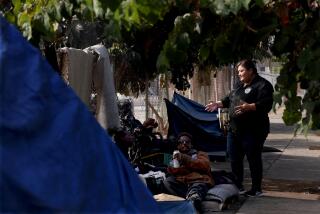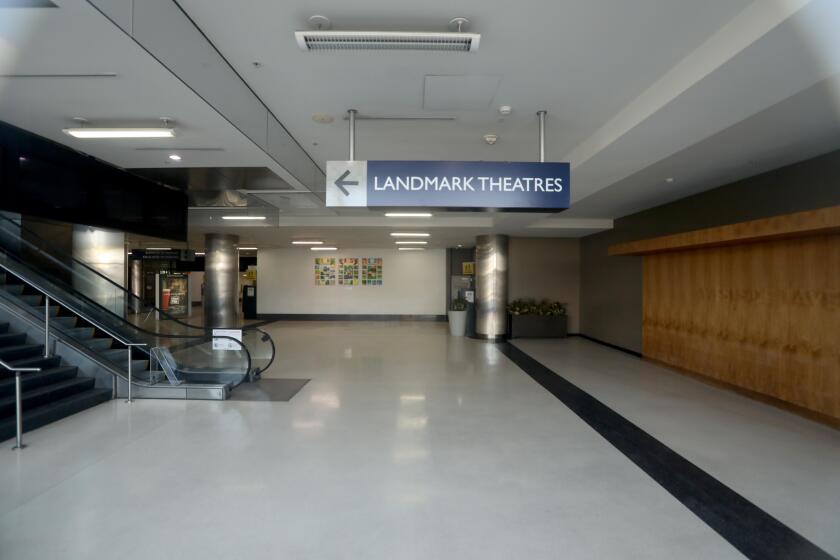Mayor offers new plan to fight gangs
Mayor Antonio Villaraigosa on Wednesday unveiled a wide-ranging strategy to curb the spread of gang violence in some of Los Angeles’ most violent neighborhoods, saying he would steer young people away from gang life by combining police suppression with stepped-up prevention and intervention programs.
Outlining the new approach during his second State of the City address, Villaraigosa said he would appoint a gang czar in his office and target eight “gang reduction zones” in South Los Angeles, the Eastside, the northeast Valley and other areas that have experienced major increases in gang violence.
In his speech at a San Fernando Valley high school, the mayor promised to devote $168 million, including $15 million in new funds, in the coming year to anti-gang enforcement and to counseling, job placement programs, parenting classes and even tattoo-removal services. The funding requires City Council approval.
Calling gang violence “the most important challenge we face,” Villaraigosa pledged to expand the anti-gang efforts to 10 additional zones, assuming he can secure an additional $30 million from the state.
“Our strategy is tough on crime and tough on the root causes of crime,” Villaraigosa told the audience of 600 in the auditorium of East Valley High School. On hand were members of the City Council, the Los Angeles Police Department’s command staff and the Los Angeles School Board.
“Take it from a former high school dropout: Fighting gangs is fundamentally a question of putting people on a path to a productive life,” he added.
Villaraigosa also devoted some of his remarks to other pressing issues.
He spoke about the city’s growing economic disparities, saying Los Angeles is “becoming a city of marble and cardboard, a city of prodigious wealth and withering poverty.”
He also talked about his ongoing campaign to rein in city expenses and his more recent effort to forge a new partnership with the school board -- a frequent adversary in the mayor’s attempts to help run the school system.
Casting himself once again as a fiscal conservative, Villaraigosa said the budget he will release today calls for reducing the city’s $231-million structural deficit by $138 million. He also pledged to expand gridlock reduction teams on Wilshire Boulevard to the San Fernando Valley and South Los Angeles, and he said he soon would announce a comprehensive plan for the city’s role in battling global climate change.
But gang violence dominated Villaraigosa’s remarks, reflecting his priorities to date this year. Along with his speech, he released a 36-page plan for a “comprehensive, collaborative and communitywide approach” to overcoming gangs.
Gang reduction zones would be in five areas already using police officers, prosecutors and probation officers to target violent gang members. They are in Boyle Heights, Watts, South Los Angeles, areas north of downtown and the northeast San Fernando Valley.
Those areas, plus three others on the Eastside and South Los Angeles, would be flooded with a mix of economic development programs, social services, job placement counseling, gang intervention groups and other efforts aimed at helping paroled convicts reenter neighborhoods as productive citizens.
The city would collaborate with the Los Angeles Unified School District to provide some of the services.
Villaraigosa said he would appoint a director for gang reduction and youth development in his office to coordinate gang-reduction programs in 19 city departments.
In addition to that, the new director will oversee an evaluation of the city’s existing 23 prevention and intervention programs, including the troubled L.A. Bridges program, and decide which ones to continue after September.
The mayor’s proposal won guarded praise from elected leaders, gang experts and academics who study the issue.
“With the energy the mayor gives on a daily basis, we are poised to continue to move forward and grow the positive things we are doing and the positive changes we are making with our young people and the problems with gangs,” said City Councilman Tony Cardenas, who heads a council ad-hoc committee on gangs.
Police Chief William J. Bratton applauded Villaraigosa’s strategy, which was developed in concert with police, gang experts and neighborhood leaders.
“Mayor Villaraigosa’s $168 million for gang prevention and intervention is the vital component missing from the city’s gang plan,” Bratton said.
Bo Taylor, president of the Unity One gang intervention program who was briefed by the mayor’s office Wednesday, called the overall concept promising.
“It has an opportunity to do something good,” Taylor said. “We just need to shape it.”
Although generally supportive, gang expert Alex Alonso said some aspects of the proposal are worrying.
“How the money gets allocated would concern me,” Alonso said. “Usually most of the budget goes toward suppression, but decades of pouring more money into suppression has not yielded acceptable reductions in gang violence. Intervention is where most of the money should be allocated.”
Villaraigosa’s prevention and intervention plan comes three months after he announced a stepped-up police enforcement effort focusing on the 11 most dangerous gangs in Los Angeles.
More than one-third of the money proposed for the gang effort -- $68.2 million -- goes to the Police Department, including $53 million for enforcement teams and an additional $6.2 million for police overtime on gang crackdown efforts.
The mayor borrowed heavily from a recent report by the Advancement Project Los Angeles, a nonprofit public policy advocacy group that had recommended a more ambitious proposal than the one he outlined: The group called on the city to target 12 “hot spots” with a greater mix of services, including economic development. It pegged the cost at $1 billion during the first 18 months.
The mayor’s plan rejected the group’s call for a new city department with its own gang czar, deciding instead to coordinate programs from his office.
Connie Rice, director of Advancement Project Los Angeles, applauded Villaraigosa for embracing one of Los Angeles’ most intractable problems but predicted that the success of his strategy will hinge on whether the new gang director has independent authority.
“This is a start,” Rice said. “But it’s unclear whether this will take us down the right road.”
patrick.mcgreevy@latimes.com
Times staff writer Steve Hymon contributed to this report.
More to Read
Sign up for Essential California
The most important California stories and recommendations in your inbox every morning.
You may occasionally receive promotional content from the Los Angeles Times.











